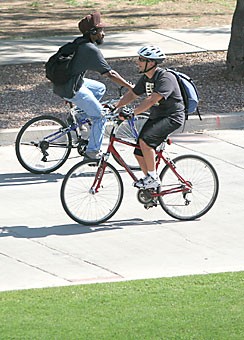There are several modes of transportation that a UA student can opt for if walking to class isn’t an option.
Purchasing a bicycle, jumping on the CatTran, calling up SafeRide or driving a personal vehicle are all ways that UA students have been getting around campus for years.
Two wheels get you there faster
Students who bike to campus have found that this mode of transportation allows them to navigate campus streets and bike paths easily and get a workout at the same time.
Aaron Thurman, a physiology sophomore, is looking forward to an easy ride to campus from his residence on North Tucson Boulevard and East Sixth Street during the upcoming school year.
Thurman, a bicycle mechanic and UA cycling club member, says the UA is extremely bike-friendly and safe for bikes as long as a proper lock is used.
Parking and Transportation Services (PTS) recommends using a U-Lock and locking both the wheel and frame to a bicycle rack.
PTS also offers students free registration for bicycle identification in case of theft.
Melanie Meyers, geography senior and UA cycling club member, says riding a bike helps her curtail parking expenses and gets her to class fast.
“”I love riding past all the cars in traffic,”” Meyers said.
Bicycles are required to follow the same rules of the road that motorized vehicles abide by, but students who choose to go on two wheels also have the option of riding on several bike paths at the UA and in Tucson.
Bicyclists may find that some streets on campus are more conducive to biking than others, like those with newer pavement.
Avoiding the pedestrian lunchtime rush around the Student Union Memorial Center is also a must for bicyclists, Thurman said.
PTS estimates that there are 11,000 bike parking spaces on campus.
Free rides
The CatTran, a free UA shuttle service, has five routes available for transporting students around campus.
In 2005, the CatTran reached a half million passengers and continued that record into the next year, said David Heineking, associate director of operations for PTS.
The CatTran has five routes: Mauve, Orange, Purple, Teal and USA.
Shuttles operate Monday through Friday, 6:30 a.m. to 6:30 p.m., with the exception of the Mauve route, which runs until 8 p.m.
All of the vehicles used by CatTran are wheelchair accessible, and drivers will help with the boarding of disabled passengers, according to the PTS Web site.
Students living outside of the university area have the option of parking their car at one of UA’s off-campus lots and taking the air-conditioned shuttle to class.
Permits are $125 for each of the five off-campus parking lots, and the shuttle ride to campus is always free.
When the sun goes down, the CatTran stops and the NightCat route takes over. The service is new for the upcoming school year through PTS.
The shuttle will circulate the campus every 30 minutes and run from 6:30 p.m. to 12:30 a.m., Monday through Friday, Heineking said.
The NightCat route will travel to University Medical Center but will not make any other off-campus stops, Heineking said.
However, SafeRide will still be transporting UA affiliated people to destinations within a one-mile radius around the campus.
SafeRide provides students with rides when they’re coming from or going to university owned or affiliated places.
SafeRide runs Monday through Thursday, 6:30 p.m. to 1 a.m. and Friday, 6:30-9:30 p.m.
Last year the service gave rides to more than 56,000 people, according to SafeRide records.
The staff at SafeRide is made up of students who are dedicated to promoting a sense of security on campus, said Peter Reifsteck, political science senior and SafeRide operations director.
“”It’s important to have students concerned about the safety of other students,”” said Reifsteck, who started working at SafeRide as a dispatcher two years ago.
The average response time (from the time the call was received to the time the caller was picked up) was 5 minutes and 20 seconds last year, according to SafeRide records.
Parking permit possibilities
Students who are planning to drive their own vehicles to campus can purchase parking garage or lot permits from PTS.
PTS does not recommend bringing a car to campus unless a parking permit has been obtained or the driver is prepared to pay for daily parking in parking garages or at street meters on campus, according to their Web site.
Disabled students have two options for permits: A Level 1 permit allows disabled students to park in Zone 1 lots and surface lots, and the Level 2 allows for the same and, in addition, parking in all garages.
The Level 1 permit costs $255 and the Level 2 costs $470 annually.
The UA has seven parking garages that are spread throughout campus: Highland Avenue, Main Gate, Park Avenue, Second Street, Sixth Avenue, Tyndall Avenue and Cherry Avenue.
Students who are interested in a parking permit for the Cherry Avenue Parking Garage must be aware that there are restrictions for parking on football and basketball game days.
Parking garage permits cost $470 and are garage-specific, while parking lot permits cost between $255 and $370, and motorcycle parking permits are $85 annually, according to the PTS Web site.
For more information about parking permits and CatTran visit the PTS Web site, www.parking.arizona.edu.









